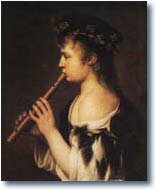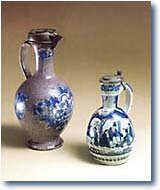The Hall
The upper storey of the Hermitage is occupied by a single vast room full of light and air. It was for the sake of this Hall that the whole building was erected. The high ceiling, huge glazed windows facing all four cardinal points, the paintings which "carpeted" the walls from top to bottom - all this gave it a solemn and festive air. The Hall was intended for a narrow circle of the owners most intimate friends who used to gather here. Fourteen people could sit in the centre of the room around the oval table with covers laid in front of each of them. The central section of the table with the serving dishes was lifted from below through a special shaft, as described above. Any participant in the feast, however, could order a meal of his own. To this end, he was to state his wish in a note, put it on the plate and pull the string. Downstairs, in the Pantry, the bell rang and the servants lowered the plate through the shaft. A little later the plate with the ordered meal was sent back to the upper storey and appeared before the guest as if by magic.
The original dining-table was lost during the war, and now only the mock-up of it is displayed in the Hall. The table, however, is laid exactly as it used to be served in the eighteenth century: fażence dishes painted in cobalt blue by Delft craftsmen in the middle of the eighteenth century, numerous wine-glasses, goblets, glasses and bottles made at that time mostly at the Imperial Glass Factory, and other items.
But the main decoration of the Hall are 124 paintings by Western European artists.The carpet-like way or hanging pictures from top to bottom was typical of the eighteenth century. The pictures were placed near one another and only the narrow gilded frame divided them. Such decoration of the walls was intended to use paintings in decorative purposes, like colour spots of fabrics or carpets.
Originally there were merely several paintings in the Hall, but in the middle of the eighteenth century, when the decision was taken to cover the walls with paintings, 151 canvases bought by Peter the Great were hung there. But in 1808 most of them perished during a fire which raged in the pavilion. The next year, after reconstruction of the building, 117 pieces were added to the four surviving pictures from Peter's virtually inexhaustible reserves kept in the stocks of the Imperial Hermitage in St Petersburg. The newly brought pictures were chosen so that the artists' names, subjects and often dimensions corresponded to those of the paintings which perished in the conflagration. The display had no alterations until the early twentieth century, when in 1925 some of the paintings "destroyed by humidity" were replaced by similar ones from the collections of the Hermitage Museum and the Gatchina Palace.
During the Second World War all the paintings (except for three large-scale canvases) were evacuated from the palace to the hinterland and returned to their original place after the end of restoration work.
The collection includes works of the Dutch, Flemish, Italian, German and French schools. Only one work on display belongs to the brush of a Russian artist. It is The Battle of Poltava, which can be seen above the staircase, formerly the lobby of the chair-lift. It was hung there in 1797, when the staircase was constructed. The Russian artist modelled his work on the painting by the French artist Pierre Denis Martin the Younger from whom Peter the Great commissioned a painting of this subject in 1725. However, the unknown Russian painter introduced some major alterations not only to the image of Peter the Great and his entourage, but to the landscape background, too.
Battle scenes were an indispensable kind of painting in Peter's palaces. The Hermitage display includes battle paintings by Jacques Courtois, called Le Bourguignon (1621-1675), the German Georg Philipp Rugendas (1666-1742) and the Italian Michelangelo Cerquozzi (1602-1660). Another genre which always attracted Peter the Great were sea scenes which the Emperor often bought himself in painters' studios during his stay in Holland. His friendship with some of artists led him to invite them to the Russian service. One such artist was Georg Gsell (1675-1740), a Swiss by birth, who studied under well-known Dutch painters and became a good connoisseur of Netherlandish art. Peter the Great relied on Gsell's knowledge in this field when he bought pictures for his palaces at auctions in Amsterdam. In 1717, Gsell entered the Russian service and lived in Russia until his death. At the present time, the Hermitage owns four of his canvases - two of them, depicting the Apostles Andrew and Paul, on the northern wall, and two, portraying the Apostles Thomas and James, on the western wall.
Gsell's advices helped Peter the Great to amass a representative collection of the "Small Dutchmen", named so for small sizes of their pictures, and masters of the Flemish school, whose works prevail in the collections of the Peterhof Palaces. Among the Dutch paintings are marines by Michiel Maddersteeg (1659-1709) and Ludolf Backhuyzen (1631-1708), landscapes by Matthias Withoos (1627-1703) and Gerrit Berckheyde (1650-1690), everyday scenes by Jan Miense Molenaer (1610-1668) and Egert van Heemskerck (1634-1704). A historical subject is treated by another Dutch painter of the seventeenth century, Nicolaes Rosendael, whose painting decorates the shield of the fireplace. It narrates about the philosopher Diogenes of Sinope who lived in Athens and at Corinth in the fourth century B.C. and practised severe asceticism. One of Greek biographers told that once, having seen a boy drinking water from his palm, the philosopher threw out his own cup. This story became the subject of this painting, one of those which belonged to the initial collection of the Hermitage.
The bright, colourful pictures by Gaspard Peter Verbruggen (1635-1649/50), Pieter van Bloumen (1657-1719) and Gerard van Opstal (1654-1717) are representatives of the Flemish school of painting.
Noteworthy among Italian paintings are Antiochus and Stratonice by Gasparo Dizziani (1689- 1767), one of the best canvases in the Hermitage collection, works by Giulio Carpioni (1611-1674), a Venetian painter of mythological scenes, and a picture by Giuseppe Recco (1634-1695), a still-life artist of the Neapolitan school. One of the most significant works in the collection is The Death of Cato by Luca Giordano (1632-1705), a painting based on the subject from the history of ancient Rome.
A small but representative and diverse collection of the Hermitage allows the visitor not only to see the world through the eyes of the artists of the seventeenth and eighteenth centuries, but also to have some idea about the collecting of the fine arts in Russia during that period.
|

The Hermitage palace
- Introduction
- The Ground Floor
- The Hall

The Hall.


The Hall.
Georg Gsell.
"The Apostle Paul."


Gerrit Berckheyde.
"Town Street".


Jan Leivensz.
"Boy with a Reed-pipe".


Gasparo Diziani.
"Antiochus and Stratonice".
|

 Complete playbill of all St. Petersburg,Russia theatres, shows, concerts, etc. !
Complete playbill of all St. Petersburg,Russia theatres, shows, concerts, etc. !
 World-known music festival "The Stars of the White Nights".
World-known music festival "The Stars of the White Nights".








